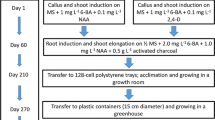Abstract
One thousand and ninety-two poplars were regenerated in vitro from callus of 13 poplar clones representing the Leuce, Aigeiros and Tacamahaca sections. At lest 44 of the regenerants differed in some way from the original clones. Somaclonal variation occurred more frequently in poplars of the Leuce section (8%) than in those of the Aigeiros or Tacamahaca sections (1%). Variation was noticed in growth habit, leaf shape or indentation but not in the reaction to four Melampsora races. However, after one growing season in the field, a few regenerants from calli of two clones (‘Ogy’ and ‘Rap’) differed in their susceptibility vis à vis the original clones. Cultivation of callus from Leuce poplars that had survived exposure to increasing concentrations of toxins from Hypoxylon mammatum gave rise to a toxin-tolerant line from which toxin tolerant plants were regenerated. Flow cytometry to measure the DNA content of nuclei showed that regenerants tended to be tetraploid.
Similar content being viewed by others
Abbreviations
- NAA:
-
naphthaleneacetic acid
- BAP:
-
benzylaminopurine
- TDZ:
-
thidiazuron
- MS:
-
Murashige & Skoog medium
References
Antonetti P (1990) Contribution à l'étude de la culture in vitro et de la vitro-variation du genre Populus. Thèse, Univ. Nancy I, no 2470
Behnke M (1980) General resistance to late blight of Solanum tuberosum plants regenerated from callus resistant to culture filtrates of Phytophthora infestans. Theor. Appl. Genet. 56: 151–152
Bergounioux C, Perennes C, Miege C & Gadal P (1986) The effect of male sterility on protoplasts division in Petunia hybrida cell cycle comparison by flow cytometry. Protoplasma 30: 138–144
Chalupa V (1974) Control of root and shoot formation and production of trees from poplar callus. Biol. Plant 16: 316–320
Galbraith DW, Harkins KR, Maddox JM, Ayres NM, Sharma DP & Firoozabady E (1983) Rapid flow cytometric analysis of the cell cycle in intact plant tissues. Science 220: 1049–1051
Larkin PJ & Scowcroft WR (1981) Somaclonal variation-a novel source of variability from cell cultures for plant improvement, Theor. Appl. Genet. 60: 197–214
Lester DT & Berbee JG (1977) Within-clone variation among black poplar trees derived from callus culture. For. Sci. 23: 122–131
Lemoine M (1973) Amélioration des peupliers de la section Leuce sur sols hydromorphes. Thèse, Univ. Nancy I, no 8205
Lutz A (1985) L'expression de la variabilité morphologique après régénération dans les cultures de tissus de cellules, In: La Variabilité des Cellules Végétales Cultivées In Vitro. Bull. Soc. Bot. Fr, Actual Bot 132. 3/4: 35–50
MacWilliam IC (1968) Wort composition-a review. J. Inst. Brew. 74: 38–53
Mestre JC & Benbadis A (1985) La variabilité des cellules végétales cultivées in vitro. Bull. Soc. Bot. Fr. 132, Actual Bot 185 (170 p)
Ostry ME & Skilling DD (1988) Somtic variation in resistance of Populus to Septoria musiva. Plant Disease 72: 724–726
Pauly MH, Shane WW & Gengenbach BG (1987) Selection for bacterial blight phytotoxin resistance in wheat tissue culture. Crop. Sci. 27: 340–344
Pinon J (1984) Propriétés biologiques de la toxine d'Hypoxylon mammatum, parasite des peupliers de la section Leuce. Rev. Cytol. Biol. Végét. Bot. 7: 271–277
Pinon J, van Dam B, Genetet I & De Kam M (1987) Two pathogenic races of Melampsora larici-populina in North-Western Europe. Eur. J. For. Path. 17: 47–53
Pinon J & Peulon V (1989) Mise en évidence d'une troisième race physiologique de Melampsora larici-populina Kleb. en Europe. Cryptogam Mycol. 10: 95–106
Pinon J (1991) Comportement des principaux clones de peuplier á l'égard des rouilles et plus praticulièrement de Melampsora larici-populina. Rev. For. Fr. 43: 301–308
Pinon J & Manion PD (1991) Hypoxylon mammatum and its toxins-recent advances in understanding their relationships with canker disease of poplar. Eur. J. For. Path. 21: 202–209
Pinon J (1992) Poplars rusts: variability and populations in France. Proc. IPC, Saragosse, Spain, 22–25 Sept 1992: 211–222
Prakash CS & Thielges BA (1989) Somaclonal variation in eastern cottonwood for race specific partial resistance to leaf rust disease. Phytopathology 79: 805–808
Sacristan MD (1982) Resistance responses to Phoma lingam of plants regenerated from selected cell and embryogenic cultures of haploid Brassica napus. Theor. Appl. Genet. 61: 193–200
Sokal & Rohlf (1973) Introduction to biostatistics (pp 103–107). Freeman, San Francisco
Skirvin RM (1978) Natural and induced variation in tissue culture. Euphytica 27: 241–266
Van Der Plank JE (1968) Disease resitance in plants. Academic Press (London) (206 p)
Author information
Authors and Affiliations
Rights and permissions
About this article
Cite this article
Antonetti, P.L.E., Pinon, J. Somaclonal variation within poplar. Plant Cell Tiss Organ Cult 35, 99–106 (1993). https://doi.org/10.1007/BF00043946
Received:
Accepted:
Issue Date:
DOI: https://doi.org/10.1007/BF00043946




